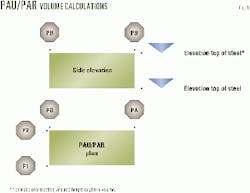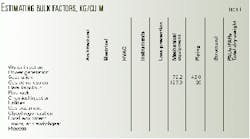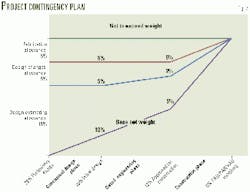Bulk factor method estimates FPSO topsides weight
Bulk factors, used successfully for weight estimating and weight control for numerous offshore fixed installations and onshore modularization projects, can also be applied, in conjunction with a database, for estimating the topsides weight of floating production, storage, and offloading (FPSOs) vessels.
Establishing an accurate estimate of the topsides weight, as early as possible, is critical in controlling costs and schedules for building these facilities.
Topsides weight estimates
Topsides weight broken down into discipline areas is fundamental for detailed cost estimates. The dry weight is used as a basis for determining loadout, lifting, and operating weights, while operating weight, with all superimposed operating loads, will establish the capacity required for the topsides substructure or vessel capacity for floating production facilities.
Weight is also a direct measure of the amount of equipment and materials that must be procured and fabricated, which has a direct bearing on project cost and schedule.
The offshore industry has over the past 20 years provided good weight data from the many offshore facilities installed, not only in the North Sea, but also in other areas of the world.
Over the past 10 years, Foster Wheeler Energy Ltd. (FWEL) has developed and used a weight-estimating database derived from actual weight reports of 60 offshore facilities.
A key feature of this effective tool is the ability to extract weight bulk factors, which can be used to estimate, with speed and confidence, the weight, and from that, the capital expenditures (Capex) required.
These estimating bulk factors (EBFs) provide a quick and accurate weight estimate for any offshore facility.
Recently, FWEL has extended this database to encompass FPSOs. A key objective has been to establish a correlation between the weights of electrical, instrument, piping, etc. and that of associated major equipment.
These estimates assist the conceptual and front-end engineering and design (FEED) phases of FPSO projects and mitigate some risks associated with weight, cost, and schedule increases that have plagued many recent FPSO projects.
With an accurate assessment of the FPSO's topsides weight during the feasibility or conceptual phase, one can control weight more easily and also produce more stable material estimates with respect to quantity and cost.
As weight data became available for FPSOs at approved-for-construction-or-better basis, FWEL investigated the same EBF approach to FPSO weight estimating as it had used earlier for fixed installations.
It carried out a study to identify correlations that exist between the weights of electrical, instrument, piping, etc. and the weight of major tagged equipment.
Modules for FPSOs tend to be smaller than those for offshore platforms and are generally known as preassembled units (PAUs), preassembled racks (PARs), and vendor assembled units (VAUs).
The dry weight of PAUs for FPSOs falls into the same three main groups as those for offshore platform modules, as follows:
- Tagged items of equipment for production operations and utility support.
- Supporting bulk items including piping, valves, instrumentation-telecommunication, electrical, cable, HVAC (heating, ventilation, air conditioning), loss prevention, and architectural.
- PAU primary, secondary structural steel, and tertiary steel, including stair towers, ladders, and walkways. Pipe racks on FPSOs are usually PAUs on their own and referred to as PARs.
Methodology
The volume of a PAU or PAR is calculated by taking the plan dimensions from the centerline of the structural beams, with elevations taken from the top of the steelwork, including any plating (Fig. 1).
To develop the bulk factors for FPSO topsides, FWEL dissected and analyzed a number of weight reports for constructed FPSOs. Typically, these reports contained data from FPSOs built in the last 4 years with topsides weighing up to 9,000 tonnes and some having more than 40 PAUs.
FWEL evaluated this weight data for more than 80 types of PAUs or areas. The weight data were first grouped into areas, such as water injection, power generation, separation, gas compression, flare knock-out, pipe rack, chemical injection, utilities, and process.
Then the weights were further separated into the disciplines of architectural, electrical, HVAC, instruments-telecommunications, loss prevention, mechanical, piping, and structural.
The study found a correlation between the weights of electrical, instruments and piping bulk items, etc. and the weight of tagged equipment.
Using the weights by discipline and the PAU-PAR dimensions, FWEL calculated a volumetric factor for each discipline and PAU type.
Table 1 categorizes the estimating bulk factors (EBFs) as operational function vs. discipline involvement.
Bulk factors sensitivity
The EBFs developed are for an average FPSO, and some skill is required in their application to a specific example. EBFs need adjustment to account for such issues as location, conversion or new-build, degree of topsides, and ships systems integration, etc.
Generally it should be emphasized that the factors in the EBF table (Table 1) are a starting point from which an engineer can proceed and refine his weight estimate as the design develops.
Adjustments to the bulk factors are necessary when the weight of tagged equipment, as assessed from the layout drawings, varies from that calculated using average EBFs.
Example analysis
The first example estimates piping bulk items in a separation PAU, with dimensions of 16 m 3 17 m 3 10 m or a volume of 2,270 cu m.
The total weight of tagged equipment in the PAU is 196 tonnes, as calculated and defined in the equipment list. The weight expressed on a volumetric basis of the tagged equipment is, therefore, (196/2,270) 3 1,000 or 72 kg/cu m.
Table 1 shows that the correlation EBF for a typical separation PAU is 72.2 kg/cu m. This value indicates that the PAU is a typical average PAU and that the EBF can be used without adjustment for estimating the weight of bulk items such as piping, electrical, etc. The weight of piping bulk items, therefore, is (42.6 kg/cu m/1,000) 3 2,720 cu m or 115.9 tonnes.
The second example illustrates an estimate of piping bulk items for a gas compression PAU, with dimensions of 37 m x 28 m 3 7 m or a volume of 7,252 cu m. The total weight of tagged equipment is 600 tonnes, as calculated and defined in the equipment list. The weight of tagged equipment expressed on a volumetric basis, therefore, is (600/7,252) 3 1,000 or 82.7 kg/cu m.
But Table 1 shows the correlation EBF for typical gas compression PAU is 127.9 kg/cu m. This, therefore, is not a typical gas compression PAU, and the piping weight along with the other bulk items needs to be adjusted by a factor of 82.7/127.9 or 65%.
Because the actual weight of PAU is only 65% of the theoretical EBF weight, the EBF for piping, electrical and instrumentation will be 65% of the value in the EBF table.
By applying the EBF value from the table without considering the inter-relationship between mechanical equipment and piping, one would estimate a piping weight of (26 kg/cu m/1,000) 3 7,252 cu m or 188.5 tonnes. But after reducing the EBF value from the table by 65%, one would obtain a weight of (16.9 kg/cu m/1,000) 3 7,252 cu m or 122.6 tonnes.
The engineer must apply his judgment to finalize a weight for input into the weight report. Because the tagged equipment to piping ratio is realistic, one can regard a value of 122.6 tonnes as a sensible weight for the piping.
Contingencies, allowances
During its study, FWEL found that on average all FPSO project weight data increased by 20% from the end of the conceptual design phase to the installation and hook-up of the PAUs, PARs, and VAUs.
This is similar to the weight growth experienced during the development of a fixed offshore facility where the same major factors caused this increase. These factors include a 10% increase due to design and estimating inaccuracies, 5% increase due to design changes, and 5% increase due to fabrication tolerance. Using these data, FWEL formulated a contingency plan for the various phases of an FPSO project.
FWEL identified three separate contingencies and allowances that can be applied to the base dry weights. Base dry weight is the net weight with no contingencies, allowances, or operating fluids added.
The design and estimating allowance is an amount, calculated as a percentage of the base weight, that represents the anticipated weight increase of each individual item resulting from inaccuracies inherent in the method of establishing the base weight of the item.
The percentage value of the allowance, which depends upon the degree of definition of the item at any particular time, can be categorized as one of the following:
- Estimating allowance, which is 15% of the base weight and is included when the origin of the base weight is derived by approximations.
- Calculating allowance, which is 10% of the base weight and is included when the origin of the base weight is derived from a design calculation.
- Material take-off allowance, which is 5% of the base weight and is included when the origin of the base weight is derived from a comprehensive material take-off from drawings, either manually or electronically.
The design and estimating allowance should, for most items, change from an estimating to a calculating allowance during the conceptual design. This is followed by a reduction to the material take-off allowance at the completion of detailed design.
The further reduction to the design-estimating allowance of the base weight should generally take place during the fabrication and construction phase.
The design change allowance is an amount, calculated as a percentage of the base weight, plus the item accuracy allowance that represents the anticipated weight growth of each individual item resulting from the development of the design as a normal part of the detailed design activity.
The fabrication allowance is for recognizing the discrepancy between the final calculated dry weight or actual weighed weight of any item, whether equipment, piping or steelwork. The discrepancy is caused by not including in calculations such corrections as 3% for over-rolling of pipe and steel sections, 1% for paint, and 1% for welding metal.
For all the PAUs, PARs, and VAUs, the recommended fabrication allowance is 5% of base weight. The fabrication allowance remains unaltered throughout the conceptual, detail design, fabrication, and construction phases and is only reduced to zero once the item has been weighed in its fabricated form.
The author:
Alan Bolding has held the position of principal consultant-weight control with Foster Wheeler Energy Ltd., Reading, UK, for the past 14 years. During his career, he has been responsible for weight control, estimating, and audits for facilities such as Statjford B, Gullfaks A, Hutton, Scott, Hibernia, Troll C., SAC (Singapore Aromatics Co.), and TARP (Thailand Aromatics Recovery Project).




